Coffee Talk and Tea Time
INGREDIENTS
Looking to add excitement to your latest food product development project? Tea and coffee, two of the most popular beverages around the world, are gaining popularity in the United States as ingredients in their own right.
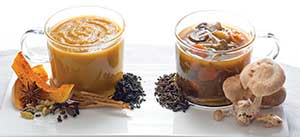 To showcase the versatility of tea and coffee and their derivatives like powders, distillates, and extracts as ingredients, ingredient manufacturers, food formulators, and culinary professionals are getting experimental, using these ingredients creatively to bring new flavor dimensions to everything from soup to nuts. Product concepts such as Wild Mushroom Pu Erh Soup from David Michael & Co., Brewed Almond Tea from the Almond Board of California, and Burnt Calamansi Iced Coffee from Sensient Flavors offer a sense of the possibilities.
To showcase the versatility of tea and coffee and their derivatives like powders, distillates, and extracts as ingredients, ingredient manufacturers, food formulators, and culinary professionals are getting experimental, using these ingredients creatively to bring new flavor dimensions to everything from soup to nuts. Product concepts such as Wild Mushroom Pu Erh Soup from David Michael & Co., Brewed Almond Tea from the Almond Board of California, and Burnt Calamansi Iced Coffee from Sensient Flavors offer a sense of the possibilities.
Enjoy a Cup of Tea Soup
There is nothing more comforting than a cup of tea or bowl of soup on a cold, blustery day. David Michael & Co., Philadelphia, Pa. (www.dmflavors.com), combines both of these into tea-infused soup product concepts, which were showcased at its 2014 Innovation Roadshow. Combining the taste-tempting flavors of tea with the familiarity of soup, David Michael scientists have put a new spin on two popular products. While the scientists note that there are plenty of flavor combinations of tea and soup, they decided to highlight the spicy notes of chai tea with the creaminess of butternut squash soup in Butternut Squash Masala Chai Soup and the umami taste of mushroom soup with the earthiness of pu erh tea in Wild Mushroom Pu Erh Soup. They also felt that the tea flavors chosen added depth to the soup bases and worked well with the savory flavors of the soups. Both soups feature flavorings from David Michael: the butternut squash soup is formulated with Natural Spice Flavor “Chai Type” and Artificial Roasted Butternut Squash Flavor, and the wild mushroom soup is formulated with Natural Flavor “Pu Erh Tea Type” and DM Choice ® Natural Mushroom Flavor WONF “Wild Type.” Product concepts like these tea-infused soups are inspiring product developers to consider tea not only in other beverages but also in sauces, marinades, salad dressings, spice rubs, baked goods, and ice cream.
This is not the first time that David Michael has highlighted the flavors of tea in other applications. At its 2012 Innovation Roadshow, the company featured the intense smoky aroma and taste of lapsang souchong tea in a cappuccino-inspired milk tea drink that it called Lapsang Cappu-Tea-No. Lapsang souchong is a black tea that gets its distinctive smoke flavor from being smoke-dried over a pinewood fire. In addition to other tea beverages and creamy, milky beverages, the tea’s smoky aroma and flavor would work well in smoothies, ice cream, alcoholic beverages like bourbon and rum, barbeque sauce, and mayonnaise, according to materials from the company.
Unexpected Twists from Sensient
Flavor manufacturers tend to pull out all the stops when they exhibit at industry shows like the IFT Food Expo. There is so much more room for flavor innovation in coffee and tea, and it is definitely the job of flavor manufacturers to encourage this among product developers, says Teresa Olah, Marketing Director at Sensient Flavors LLC, Hoffman Estates, Ill. (www.sensient.com). This is exactly what the company did for the 2014 IFT event, where it featured two flavorings from its 2014 Trends to Taste program in tea and iced coffee.
Gochujang is a condiment made from red chili, rice, fermented soy-beans, and salt. Sensient flavorists created a flavoring that captured some of the heat, umami, and slightly sweet notes of gochujang and used it in Cool Chocolate Gochujang Black Tea. The familiar flavors of vanilla and chocolate along with Sensient’s Coolenol ™ flavoring ingredient for a cooling sensation helped to make it a little more appealing to those a bit timid about trying something with an unfamiliar ingredient like gochujang. Calamansi tastes like tart lime and mandarin, and flavorists can add layers of complexity to a calamansi flavoring with caramelized or burnt notes. Sensient formulated a burnt calamansi flavoring that combined the tartness of citrus with caramelized sugar in Burnt Calamansi Iced Coffee, a beverage that Olah says is not going to replace your morning coffee but rather is a good alternative to a dessert.
--- PAGE BREAK ---
New Potential for Flavors of Coffee, Tea
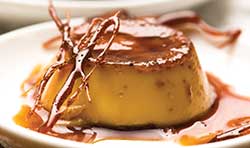 Coffee and tea flavorings, extracts, and distillates allow product developers to enhance the flavor of tea and coffee beverages or add various flavor and aroma notes from coffee and tea to other applications like custard, ice cream, bakery, sauces, and alcohol. These ingredients also offer consistency from batch to batch.
Coffee and tea flavorings, extracts, and distillates allow product developers to enhance the flavor of tea and coffee beverages or add various flavor and aroma notes from coffee and tea to other applications like custard, ice cream, bakery, sauces, and alcohol. These ingredients also offer consistency from batch to batch.
During the coffee roasting process, chemical reactions take place that develop bitter-tasting compounds and volatile aroma compounds, of which there are more than 1,000 (Chu, 2012). Some of these aroma compounds have buttery, caramel, spicy, earthy, nutty, green, and roasted notes. The processing also affects the quality and quantity of bioactive compounds. How coffee is brewed and the temperature of the water used in the brewing process play roles in the chemical composition of coffee, too.
Tea comes from the leaves of the Camellia sinensis plant. The length of time that the tea leaves are oxidized determines the type of tea—black, green, semi-oxidized, yellow, and white. Dark tea includes pu erh, a black tea in which the fermentation is sped up, and compressed green tea, in which the leaves are formed into cakes or bricks and left to age for a period of time. There are scented, smoked, and flavored teas, and “teas” made strictly from herbs, flowers, and spices. All of these have distinguishing flavor and aroma characteristics such as green, grassy, gamy, woody, floral, herbaceous, marine, earthy, burnt, smoked, mineral, and spicy.
FONA, Geneva, Ill. (www.fona.com), promotes its line of coffee-inspired flavorings as ingredients to bring various flavor nuances of coffee to grain-based products. Included in the line are two amaretto flavorings, one with sweet, almond, and brown notes and the other with sweet, almond, and buttery notes; caramel with milky, burnt sugar notes; chocolate cream coffee with chocolate, roasted coffee, and sweet cream notes; and coffee with dark roasted notes and full-bodied coffee flavor that lingers. Also in the line are French roast coffee with notes of robust, dark roasted coffee; hazelnut with woody, roasted, and creamy notes; two latte flavorings, one with notes of cream, milk, brown, and roasted coffee and the other with creamy, buttery coffee with caramel notes; and tiramisu with creamy, coffee, rum, and chocolate notes.
Known as a worldwide manufacturer and supplier of vanilla, Virginia Dare, Brooklyn, N.Y. (www.virginiadare.com), is also well-established in providing tea ingredients to the food industry. Through its proprietary tea extraction technology processes that begin with tea leaves and brewed tea, the company produces tea concentrates, flavorings, and powders, and can add fruit, spice, herbal, and vanilla flavorings to these ingredients. The tea ingredients are increasingly used in ready-to-drink beverages, nutritional products, confections, bakery, and frozen desserts. Even distillers and mixologists incorporate the ingredients to develop tea-infused spirits. In response to the growth in ready-to-drink tea beverages, Virginia Dare developed Tea Concentrate TT99 for use in these applications. The ingredient is said to provide the beverages with a full tea flavor without the need to use tea solids. Analysis of the concentrate shows that it is fairly balanced in tannic, sweet, prune, acid, and fruity notes. Scientists with the company formulated Chocolate Tea Ready-To-Drink Beverage product concepts in milk chocolate and dark chocolate versions to showcase how Tea Concentrate TT99 adds flavor top notes associated with tea to a sweet, chocolaty beverage.
The Synergy Pure™ Tea Extracts and Essences from Synergy Flavors Inc., Wauconda, Ill. (www.synergytaste.com), are produced using a proprietary extraction process whereby the volatile flavor components are captured (these are the essences used to enhance the aroma of foods and beverages) and then soluble solids are extracted and concentrated. The versions in the line feature extracts and essences of black, green, and white tea and rooibos, all of which function in ready-to-drink beverages, concentrates, syrups, and juice and tea blended beverages. The alcoholic beverage product category is experiencing growth in the use of tea flavors, with sweet tea vodka, wild tea, and sweet Carolina peach as some flavor variations noted by the company. As a special treat for attendees at the 2014 IFT Food Expo, the food scientists at Synergy served a Honey Green Tea along with iced coffees in beignet, praline, and chicory flavors made with extracts and concentrates from the Synergy Pure tea and coffee line.
--- PAGE BREAK ---
A nonthermal patented extraction process used by S&D Coffee & Tea Extracts & Ingredients, Concord, N.C. (www.sndflavors.com), is said to produce coffee extracts that have the subtle flavors and aromas not achieved by using thermal extraction methods. Called the Toddy ® Cold Brew Process, the method uses cooler extraction temperatures, which makes it possible to avoid extracting certain volatile oils like undesirable astringent notes, according to the company. During the 2014 IFT Food Expo, the company served Nitrogen Infused Coffee that was formulated with its cold brewed coffee extract. Representatives from the company explained that the nitrogen further enhanced the coffee extracts by curbing the acidity levels and adding perceived sweetness to the coffee.
By using concentrated liquid brewed tea solids such as those manufactured by Amelia Bay, John’s Creek, Ga. (www.ameliabay.com), beverage formulators can develop “brewed” ready-to-drink tea-based beverages without using caramel coloring or dealing with the overhead cost of kettle brewing, according to the company. These ingredients, which are produced using proprietary extraction processes that separate the solids from the brewed tea, allow for “brewed tea” label claims, can be used in both hot-fill and cold-fill packing methods, and add flavor, color, and mouthfeel to finished beverages.
Coffee extracts from Autocrat LLC, Lincoln, R.I. (www.autocrat.com), range in flavor from light roast with hints of caramel for Coffee Extract 303 and a smooth, well-rounded coffee flavor for Coffee Extract 660, to bold, crisp flavor with a medium body for Coffee Extract 956 and intense smoky flavor for Coffee Extract 999. Other extracts illustrate some of the flavor and aroma complexities of coffee; these include the 100% Colombian Extract 310 with rich, silky, and medium roast coffee notes; Espresso Coffee Extract 142, a deep, rich blend of robust coffees; and Sumatran Blend Coffee Extract 1018, with a heavy body and earthy and spicy finish. Autocrat highlights its tea ingredients in a number of concepts designed to help product developers add value and capitalize on trends like healthier foods or flavors that set products apart from the competition. One such concept is Sesame Ginger Green Tea Dressing, which combines the green and floral flavors of green tea with potential health benefits of green tea extract in a salad dressing that goes beyond ranch or Italian varieties.
Using mostly Colombian and Kenyan Arabica beans, Teawolf, Pine Brook, N.J. (www.teawolf.com), produces clear coffee distillates that have highly concentrated robust flavor generally associated with coffee brewed from these beans. Since the distillate is clear, it adds coffee flavor without affecting the color of the finished product, particularly in clear-colored beverages and light-colored foods like yellow cake and frostings. For its range of coffee extracts, the company extracts compounds from coffee beans and then concentrates them to specific solids percentages.
Discovering Ways to Cook with Tea
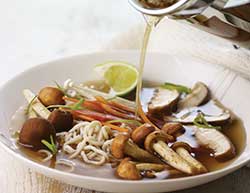 For the annual McCormick’s ® Flavor Forecast ® reports, culinary and food product development experts provide insights into the global trends that will affect what people cook and eat for that year and beyond. The 2014 Flavor Forecast includes five flavor insights expected to help inspire culinary and product development professionals. One of these, which McCormick calls “Clever Compact Cooking,” focuses on using some familiar, everyday ingredients to create new flavor sensations. Tea is one such ingredient pointed out by the experts as finding its way into foods and beverages through spice rubs (where crushed tea leaves are blended with herbs and spices), marinades, and the use of cooking liquids in place of broths, according to Laurie Harrsen, Director, Consumer Communications & PR, at McCormick & Co. Inc., Hunt Valley, Md. (www.mccormick.com). Tea used as a cooking ingredient is well-established in some locations like India and the United Kingdom, she notes, and now it is catching on in the United States.
For the annual McCormick’s ® Flavor Forecast ® reports, culinary and food product development experts provide insights into the global trends that will affect what people cook and eat for that year and beyond. The 2014 Flavor Forecast includes five flavor insights expected to help inspire culinary and product development professionals. One of these, which McCormick calls “Clever Compact Cooking,” focuses on using some familiar, everyday ingredients to create new flavor sensations. Tea is one such ingredient pointed out by the experts as finding its way into foods and beverages through spice rubs (where crushed tea leaves are blended with herbs and spices), marinades, and the use of cooking liquids in place of broths, according to Laurie Harrsen, Director, Consumer Communications & PR, at McCormick & Co. Inc., Hunt Valley, Md. (www.mccormick.com). Tea used as a cooking ingredient is well-established in some locations like India and the United Kingdom, she notes, and now it is catching on in the United States.
To help product developers explore the possibilities of formulating with tea and inspire home cooks, the experts at McCormick presented five recipes that use tea in different ways. Lapsang souchong tea gives a smoky flavor to Vegetable Pho when used in a tea broth. Lemon-flavored herb tea is infused into custard as a complement to ground ginger and candied apricots in Easy Lemon Tea-infused Custard with Candied Apricots. Green tea is steeped along with dry seasonings, onion, and chicken to add green and mild herb flavors to Cajun Spiced Chicken Risotto. The seasoning for Tea-Rubbed Pork Chops features ground black tea leaves, Chinese five spice, and grated orange peel. Greek mountain tea, which is brewed from sideritis, a genus of flowing plants found in Mediterranean regions, pairs with oregano for the foundation of a sauce for Greek Spaghetti. In these recipes, different teas are used depending on their flavors and how they pair with other ingredients. The smoky note of lapsang souchong works well in a savory broth for the pho application but also provides great flavor to spice rubs for meat. Harrsen also comments that white tea and light flavors like citrus and fruity flavors like plum make great flavor combinations.
In addition to the information and recipes from the 2014 Flavor Forecast that promote tea as an ingredient, McCormick offers a marinade made with crushed tea leaves. Grill Mates® Smokin’ Sweet Tea Marinade is a dry seasoning blend that the company says will give chicken, pork, or steak “a sweet tea profile with smoke, spices, and herbs.”
--- PAGE BREAK ---
Value-Added Coffee and Tea Have Market Potential
 Coffee provides people with a caffeine boost to help them start their day, and thanks to nutrient premixes from DSM Food Specialties, Parsippany, N.J. (www.fortitechpremixes.com), they can also get a dose of antioxidants and other vitamins. Fortifying beverages with nutrients and other ingredients is not new, but ingredient manufacturers and food formulators continue to explore beverage options worth fortifying, additional ways to fortify beverages, and the particular nutrient or combination of nutrients for a particular beverage. Some blend the ingredients with the coffee or use various technologies to infuse the coffee beans with them. In DSM’s case, the company served brewed coffee fortified with a custom nutrient premix of vitamins A, C, D-3, and E and B vitamins from Fortitech® Premixes by DSM to attendees at the 2014 IFT Food Expo.
Coffee provides people with a caffeine boost to help them start their day, and thanks to nutrient premixes from DSM Food Specialties, Parsippany, N.J. (www.fortitechpremixes.com), they can also get a dose of antioxidants and other vitamins. Fortifying beverages with nutrients and other ingredients is not new, but ingredient manufacturers and food formulators continue to explore beverage options worth fortifying, additional ways to fortify beverages, and the particular nutrient or combination of nutrients for a particular beverage. Some blend the ingredients with the coffee or use various technologies to infuse the coffee beans with them. In DSM’s case, the company served brewed coffee fortified with a custom nutrient premix of vitamins A, C, D-3, and E and B vitamins from Fortitech® Premixes by DSM to attendees at the 2014 IFT Food Expo.
In addition to fortifying coffee with vitamins, product developers are using other nutrients to add value to both coffee and tea and to differentiate their product from the competition. A single-serve coffee and an herbal tea fortified with probiotics are two products that offer consumers added value in popular beverages. “It’s become widely accepted that probiotics need to be consumed every day,” remarks Mike Bush, Senior Vice President of Ganeden Biotech, Mayfield Heights, Ohio (www.ganedenbiotech.com), the company that manufacturers the patented probiotic GanedenBC 30 (Bacillus coagulans GBI-30, 6086) used in the two products. The question for the Ganeden experts was how could they get people to consume probiotics every day and make it part of their lifestyles without having to form new habits, he says. Company experts investigated beverages like coffee and tea that are consumed on a daily basis and worked with Copper Moon Coffee to develop French Vanilla Cappuccino Insta-Kups™ and with Bigelow to develop Lemon Ginger Herbal Tea Plus Probiotics. GanedenBC30 is a spore-forming bacterium that starts out in the dormant stage and then germinates when it enters the gut. Its long shelf life, heat tolerance, and low sensitivity to moisture make it quite useful in applications like the ones offered by Copper Moon and Bigelow, adds Bush.
As part of its 100 Years, 100 Innovations 2014 campaign, Edlong Dairy Technologies, Elk Grove Village, Ill. (www.edlong.com), featured Easy Energizer-Protein Coffee Beverage as one of 100 innovations that can address product development challenges and inspire food formulators. For the coffee beverage, Edlong food technologists combined milk, sugar, instant coffee, and coffee extract with a beverage flavoring, salt, carrageenan gum, and a vitamin premix and fortified it with milk protein concentrate. Not only does the beverage provide a caffeine boost, it also contains 18 g of protein for more sustained energy and satiety and B vitamins for cell metabolism. The beverage is heat-stable and can be processed using ultra-high temperature processing without affecting flavor or texture, according to materials on the company’s 100 years, 100 Innovations website (http://100flavorfulyears.com). A sample formulation is available on the site as well.
One of the product concepts that Cargill Inc., Minneapolis, Minn. (www.cargill.com), featured during the 2014 IFT Food Expo was an Iced Coffee Mocha with Omega-3s. Omega-3 fatty acids are increasingly used in products, particularly beverages. Cargill food technologists fortified the coffee beverage with the company’s new IngreVita™ EPA/ DHA Omega-3 Oil to tap into the consumer demand for better-for-you indulgent products. The company says that IngreVita does not impart a fishy flavor or aroma to the coffee beverage.
Product Concepts Focus on Healthful Components
Research points to potential benefits that certain compounds in green tea may have on cognitive health and cancer, and some studies are examining the effects of green tea extract on the immune system. Ingredient manufacturers are already positioning green tea extracts as immune-enhancers, as Naturex, South Hackensack, N.J. (www.naturex.com), did when it featured its green tea extract in a beverage concept called I Drink at the 2014 IFT Food Expo. The extract, which contains antioxidants, has controlled bitterness and reduced levels of astringency, according to the company. For additional immune system enhancement, the beverage contained echinacea, elderberry, and goji.
Another example of a beverage formulated with green tea extract featured at the IFT Food Expo was Resteasy Peach Tea Relaxation Drink from DSM Food Specialties, Parsippany, N.J. (www.dsm.com). This peach-flavored tea contained Teavigo ® caffeine-free green tea extract. The ingredient contains epigallo-catechin gallate (EGCG), one of the most powerful antioxidants in green tea widely studied for its potential positive effects on suppressing tumor growth, enhancing cognitive functions, and improving heart health.
BI Nutraceuticals, Long Beach, Calif. (www.botanicals.com), also served a green tea extract–fortified beverage at the event; it was called Antioxidant Hurricane Lemonade. As a manufacturer of powders and extracts, including green tea extracts in versions 15% EGCG, 8% caffeine; 45% EGCG, 98% polyphenols, 75% catechins; 50% EGCG decaffeinated; 15% polyphenols; fortified with 50% caffeine; and fortified with 80% caffeine, BI Nutraceuticals provides its customers with plenty of examples of product concepts and formulations that feature its green tea extracts and more. During the 2013 IFT Chicago Section Suppliers Night, representatives from the company explained how green tea extracts give beverages added functionality without significantly changing the flavor, appearance, or other qualities of finished products. In the company’s Applications Bulletins booklet distributed at the event, an example showed how the 45% EGCG, 98% polyphenols, 75% catechin green tea extract can add 50 mg of polyphenols to a carbonated beverage.
For beverages and instant drinks, Nexira Inc., Rouen Cedex, France (www.nexira.com), offers Green Tea Extract 80 and Green Coffee Extract. A water extraction process on the tea leaves produces an extract that the company reports has 80% polyphenols and 5% caffeine. The green coffee extract, which is also produced using a water extraction process on green coffee beans, contains 15% chlorogenic acid and 6% caffeine. Both extracts are said to be heat- and light-stable and soluble in cold water. The green tea extract ingredient is said to function in any pH environment, while the green coffee extract works in pH that is less than 6.0. The green tea extract also functions in confectionery applications.
--- PAGE BREAK ---
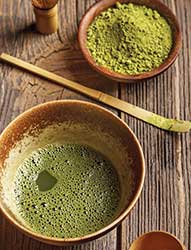 Matcha Makes Other Teas Green with Envy
Matcha Makes Other Teas Green with Envy
It is said that in the 12th century, the Buddhist monk Eisai and his disciples introduced tea to Japan upon returning from a trip to China. The Chinese crushed tea leaves into a powder and whisked it with hot water. The Japanese made this method—and the tea used in it—their own when they elevated it to ceremonial status as part of the Cha No Yu tea ceremony started in the 16th century. Since then, the Japanese have enjoyed the powdered green tea called matcha as part of formal tea ceremonies and for relaxation. The tea, which has a slightly bitter taste with green, herbaceous notes, and an intense, dark green color, is also enjoyed as an ingredient in ready-todrink beverages, bakery, confections, frozen desserts, and even savory dishes.
Aiya America, Torrance, Calif. (www.aiya-america.com), offers two grades of matcha: a ceremonial grade for drinking straight and a cooking grade. The company blended the cooking-grade matcha for use in culinary and product development applications where sugar, milk, and other ingredients are used. With a stronger flavor than the ceremonial-grade matcha, the cooking-grade version produces a characteristic matcha flavor when mixed with other ingredients and processed into products like smoothies, confections, and more. Representatives from the company presented food product developers at the 2014 IFT Food Expo with formulation examples like Matcha Tofu Ice Cream, Matcha White Chocolate Salted Caramel Bonbons, Matcha Chocolate Chip Rice Cookies, Matcha Smoothie, and Matcha Latte.
Inspiration for Product Formulation
Ingredient manufacturers, industry trade shows, and culinary magazines are a rich source of ideas for using coffee and tea and derivative ingredients in product development efforts.
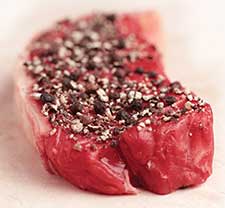 • Food magazines serve as sources to help spur culinary creativity, and a magazine like Saveur presents recipes that incorporate ingredients both familiar and exotic that span the world. Some of the recipes for coffee and tea beverages or ones that use coffee and tea as ingredients that are available on the magazine’s website are Indonesian Coffee with Ginger, Vietnamese Coffee Ice Cream, Coffee- and Soy-Marinated Flank Steak, Coffee Barbeque Sauce, Coffee-Crusted Beef Tenderloin, Rye-Spiked Cinnamon Tea, Sichuan Tea-Smoked Duck, Green Tea Rice, and Matcha Green Tea Glaze.
• Food magazines serve as sources to help spur culinary creativity, and a magazine like Saveur presents recipes that incorporate ingredients both familiar and exotic that span the world. Some of the recipes for coffee and tea beverages or ones that use coffee and tea as ingredients that are available on the magazine’s website are Indonesian Coffee with Ginger, Vietnamese Coffee Ice Cream, Coffee- and Soy-Marinated Flank Steak, Coffee Barbeque Sauce, Coffee-Crusted Beef Tenderloin, Rye-Spiked Cinnamon Tea, Sichuan Tea-Smoked Duck, Green Tea Rice, and Matcha Green Tea Glaze.
• Virginia Dare, Brooklyn, N.Y. (www.virginiadare.com), reports on a number of tea flavor trends product developers should note in its Tea Trends and Concepts report. Green tea and black tea are the top two tea flavors, according to new product introductions from January 2013 to January 2014 as tracked by Innova Market Insights. This is followed by herbal, lemon, lemonade, chai, ginseng honey, peach, and chamomile. While these flavors are well-established by tea beverage manufacturers, other flavors are appearing in specialty, seasonal, and health-focused tea products. The Virginia Dare report points out smoked teas with subtle to strong smoke flavors or teas that capitalize on flavors of the season like pumpkin spice and candy apple for autumn and gingerbread and candy cane for the Christmas season. Other teas use herbs and plants like ginger and elderflower to flavor teas for reported medicinal purposes. Finally, teas flavored with tropical fruit flavors or floral flavors continue to gain popularity.
• Try flavoring tea beverages with exotic fruit flavorings as Bell Flavors & Fragrances Inc., Northbrook, Ill. (www.bellff.com), did with its Caja Tea Flavored Beverage. The product concept, featured at the 2014 IFT Food Expo, was made with caja flavoring. Caja, a fruit from the Amazon rainforest, has a citrusy, sweet taste.
• The warm spice cardamom paired with pear in an autumnal Pear Cardamom Tea that Wild Flavors Inc., Erlanger, Ky. (www.wild-flavors.com), served to IFT Food Expo attendees.
• IFT held its 2014 expo in New Orleans, and Ingredion Inc., Westchester, Ill. (www.ingredion.com/us), developed a New Orleans cuisine–themed Chicory Coffee Dipping Sauce and Mini Beignets product concept.
• The Almond Board of California, Modesto, Calif. (www.almonds.com/food-professionals), developed Brewed Almond Tea with an almond tea base made from roasted whole blanched almonds, sugar, water, almond milk, and almond foam.
• Coffee Direct, Hunterdon County, N.J. (www.coffeebeandirect.com), manufactures smoked coffee. The smoke flavor comes not from liquid smoke flavoring but from a slow-smoking process of the beans. The product line consists of Original Smoked Coffee, Vanilla Bourbon, Maple Bacon, Campfire S’more Smoked Coffee, and Café Fume Smoked Coffee.
• Vegetables, herbs, spices, and decaffeinated tea are blended into Savory Tea™ from Numi Organic Tea, San Francisco, Calif. (www.numitea.com). The company positions the tea as a snack, a complement to a lunchtime meal, or to use for cooking rice or noodles. Numi also offers several versions of Indulgent Tea that blend tea and chocolate with bergamot, vanilla, mint, and chai spices.
www.ift.org
Members Only: Read more about coffee and tea online at www.ift.org. Type the keyword into our search box at the upper right side of our home page.
 Karen Nachay,
Karen Nachay,
Senior Associate Editor
[email protected]
